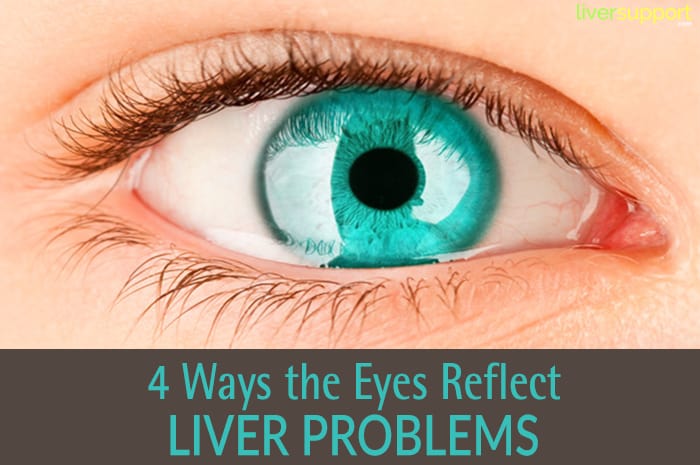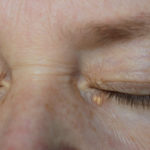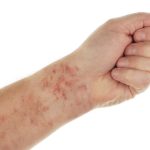
Previous
Is Non-Dairy Creamer a Smart Choice for Your Liver?

Next
Honey – A Sweetener Your Liver Can Appreciate
4 Ways the Eyes Reflect Liver Problems
Noticing one of these four manifestations in the eyes can help people prevent or address an emerging issue with their liver’s well-being.
An old English proverb originating from a passage in the Bible [Matthew 6:22-23] states, “the eyes are the window to the soul.” This implies that looking deeply into a person’s eyes reveals who they truly are on the inside. In another perspective of this well-known adage, various medical traditions demonstrate that observing a person’s eyes also foretells of their liver health.
The strong correlation between the liver and the eyes is recognized via four different kinds of associations.
#1 – Scleral Icterus
Usually white to off-white and opaque, the sclera is the white part of a human eye. When the sclerae are yellow, jaundice (icterus) is the most common culprit. Yellowing of the eyes, sclera icterus, is frequently a sign of liver damage or liver disease.
Jaundice is caused by a buildup of bilirubin, the byproduct of old red blood cells the liver can’t process. While most people associate jaundice with yellowing of the skin, the whites of the eyes are typically the first tissue to be affected by an injured liver that is unable to remove bilirubin from the blood supply.
Scleral icterus is different from pinguecula, light-yellow colored bumps on the sclera. Although pinguecula usually appear in the corner of the eye near the nose, they can appear anywhere on the sclera. Believed to be a fatty deposit, pinguecula are usually a result of irritation from the elements, such as dust, wind and sun exposure.
#2 – Xanthelasma Palpebra
Xanthelasma palpebra are tiny yellow bumps on the eyelids. Sometimes referred to as “cholesterol bumps,” xanthelasma palpebra is typically a warning that a person has high cholesterol. These bumps are frequently mistaken for a stye, but xanthelasma palpebra usually consists of multiple, very small bumps. Because high cholesterol frequently accompanies fat accumulation in the liver, xanthelasma palpebra could be a warning of the easily missed, very common, and potentially dangerous condition known as fatty liver disease.
#3 – Dry Eyes
While dry eyes can have many different etiologies, dry eyes accompanied by pallor, fatigue, blurry vision, thirst, absence of menstruation, muscle cramps, floaters in the eye and poor night vision all have a common denominator in Traditional Chinese Medicine (TCM). In TCM, these concurrent symptoms could indicate liver blood deficiency, an imbalance that has the potential to hinder optimal liver function. Please note that TCM detects imbalances in the body before they manifest as an illness; as such, a diagnosis of liver blood deficiency in TCM does not necessarily imply liver disease.
#4 – Irregularity Between the Eyebrows
One of the hallmark diagnostic measures in TCM is observation. The Chinese see the body as a whole, where each organ is related to the rest of the body. As such, looking closely at certain areas of the body can offer big clues to its associated organ system. This connection has many applications, one of which is useful when an anomaly is seen between the eyebrows – an area that relates to the condition of the liver.
A vertical line between the eyebrows may indicate liver problems that encompass impaired liver health due to alcohol, poor dietary choices or high stress levels. Evidenced by a crease in the forehead’s center, excessive fat in the diet or food intolerances can negatively impact the liver. In TCM, the liver is the organ that holds anger – and it can be injured from rage. A precursor to congestion in the liver, a deep frown line is frequently found on those who either suppress their anger or get angry quickly; both contributing to potentially harmful liver congestion.
Encompassing tenets of both Western medicine and Chinese medicine, the eyes are a sort of window into the liver’s well-being. If you notice any of the four mentioned signs – jaundiced sclera, yellow eyelid bumps, dry eyes or a line between the eyebrows – don’t panic. In many cases, observing one of these four signs can function as motivation to be evaluated by a knowledgeable healthcare practitioner. Armed with this knowledge, you can take an active role in preventing and/or addressing any possible liver ailments.
http://drlatib.com/2013/03/facial-diagnosis-in-traditional-chinese-medicine/, Facial Diagnosis in Traditional Chinese Medicine, Retrieved June 30, 2013, drlatib.com, 2013.
http://health.yahoo.net/caring/14-things-your-eyes-say-about-your-health, 14 Things Your Eyes Say About Your Health, Paula Spencer Scott, Retrieved June 30, 2013, Caring.com, 2013.
http://www.ask.com/question/eyes-are-the-window-to-the-soul-proverb, Eyes are the Window to the Soul Proverb?, Retrieved June 30, 2013, ask.com, 2013.
http://www.carahealth.com/health-conditions-a-to-z/special-senses/general-eye-health/239-eyes-are-the-window-to-the-soul.html, Chinese Medicine and the Eyes, Retrieved June 30, 2013, Carahealth, 2013.
http://www.dermalinstitute.com/us/library/33_article_Ancient_Diagnosis_Modern_Results_.html, Ancient Diagnosis, Modern Results, Jane Wurwand, Retrieved June 30, 2013, The International Dermal Institute, 2013.
https://www.liversupport.com/four-facial-liver-health-clues/, Four Facial Liver Health Clues, Nicole Cutler, L.Ac., Retrieved June 30, 2013, Natural Wellness, 2013.
http://www.livestrong.com/article/316251-bumps-on-the-white-part-of-the-eye/, Bumps on the White Part of the Eye, Ivy Morris, Retrieved June 30, 2013, Demand Media, Inc., 2013.
http://www.medterms.com/script/main/art.asp?articlekey=3890, Icterus definition, Retrieved June 30, 2013, MedicineNet, Inc., 2013.
http://www.milesresearch.com/main/eyesigns.asp, Key Ocular Signs for Screening, Retrieved June 30, 2013, Miles Research, 2013.
Maciocia, Giovanni, The Foundations of Chinese Medicine, Churchill Livingstone, New York, NY, 1989; 146-147.










